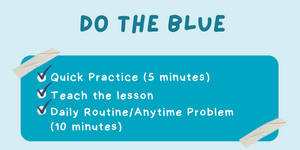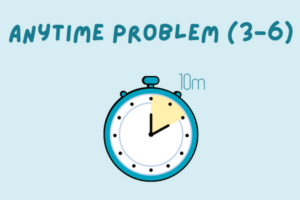Do you remember hearing “Do The Blue” but don’t remember what it refers to? Quick Practices (K-6th), Daily Routines (K-2nd), and Anytime Problems (3rd-6th) are all parts of the “Doing the Blue” section of lessons in Math Expressions. “Doing the Blue” are the main components of the lesson that should be taught.

Quick Practices, Daily Routines, and Anytime Problems are an important part of the process and student learning in math. These practices and routines focus on concepts and skills throughout the year that are needed for student mastery. They build classroom belonging and develop student leaders, as well as build a strong math-helping community.
It is recommended that teachers start each lesson with the Quick Practice. Generally, Quick Practices are directed by student leaders with all students having opportunities to be student leaders throughout the school year. The Quick Practice should last no more than 5 minutes; setting a timer can help manage that chunk of time. Teacher preparation for the Quick Practice, however, may not be as convenient. Teachers need to flip pages to the QP section of the manual or grab the teacher resource book to get detailed directions. With some lessons, teachers also need to gather other materials/manipulatives.
Daily Routines are crucial for students in Kindergarten through second grade and should be done daily for ten minutes. Daily Routines focus on the concepts and skills that take time to build as the year progresses. They also help to develop number sense and fluency. It is easy to get wrapped up in the routines, so setting a timer for ten minutes can be helpful. If you are not able to progress to the second part of the routine in that time frame, start the next day with the part of the routine you didn’t get to so that if you run out of time again, you are still getting to each part of the routines over time.
Anytime Problems build problem-solving skills and collaboration among students. It is important to fully explain the problem so students understand what is being asked and can begin to work collaboratively. It is recommended to start out the year working through the Anytime Problem as a whole group. Once students have had enough time to understand the routine, move to small groups, then to partners, and finally individually. Do not spend more than 10 minutes on this task; setting a timer may help. If the problem isn’t finished, students can come back to the problem at a later time in the day.
During this process, teachers may think they should just skip the Quick Practice, Daily Routines (K-2nd), and Anytime Problems (3rd-6th) since it is time consuming to plan only meant to be a short instructional practice. This is NOT best practice.
Dodie Norris, District Math Specialist, Elkhart Community Schools
We have great news! We have created a resource for all Math Expressions units K-6 that compiles Quick Practices and Anytime Problems (3rd-6th) into Google Slides. Each slide contains the instructions and visuals needed. We did not include the Daily Routines (K-2nd) as these utilize math manipulative resources such as posters, flip charts, large group cards, etc.
It is highly recommended that you open these slides using your laptop and choose “Presenter View” from the slideshow dropdown arrow. This will present the slide on your projector while giving you the instructions on your laptop. You are able to advance to the next slide(s) too. Check out how below:

There are many different ways you can use these slides in your classroom. The most basic way is to open the slides on your laptop and project the slides with your classroom projector, using pointers and dry-erase markers to interact with the content. If your classroom is equipped with an interactive whiteboard, you can use the pen tool to manipulate the slides (tip: Use ActivInpire’s Dashboard “Desktop Annotate” feature to write). If you would like your students to each work on a slide using their iPad, you will need to make a copy of the slides, delete all slides unrelated to the lesson, and send a forced copy to students. (Tip: send the forced copy link in a Seesaw activity).
Need more guidance on how to use the slides? Check out this video!
If you prefer digital slides for the K-2 Daily Routines or need other K-6 digital resources, this resource created for remote learning may be useful.
We hope you find these slides useful. Teachers in Elkhart Community Schools can book personalized sessions with the Elementary Math Specialist here. Leave a comment to let us know how you plan to / or are using these slides!






